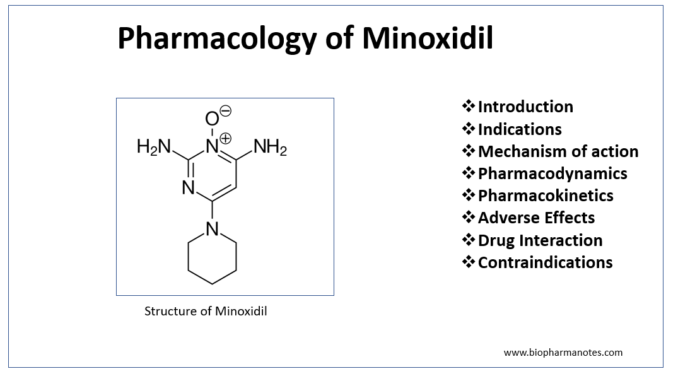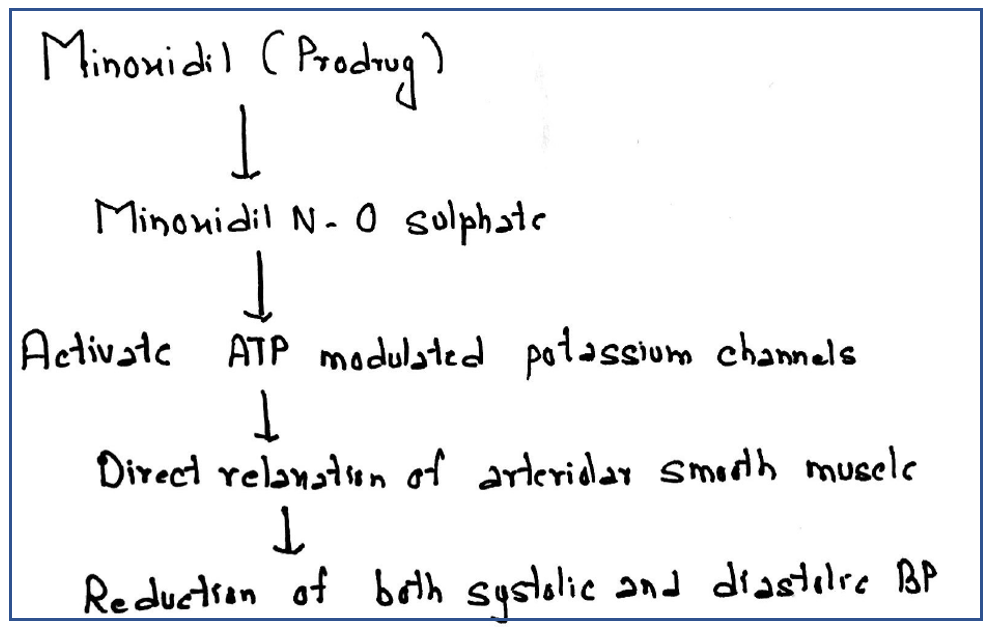
- Minoxidil is potassium channel activator and a powerful vasodilator.
- It was first introduced to treat high blood pressure. One of its side effects discovered was increase in growth and darkening of fine hairs of body. This leads to development of its topical formula and use for hair fall.
Indications of minoxidil
- Used to treat severe and drug resistant forms of hypertension.
- It is available as over the counter topical liquid or foam to treat hair loss in male and female. Used in androgenic alopecia and alopecia areata.
Mechanism of action

Figure- Mechanism of action of Minoxidil
- Potassium channel play important role in maintaining cell excitability and membrane potential.
- Minoxidil is a prodrug which is converted to its active metabolite minoxidil N-O sulfate. This metabolite activates ATP modulated potassium channel in smooth muscle. It leads to hyperpolarization and direct relaxation of arteriolar smooth muscle. This results in its anti-hypertensive effect. It increases blood flow to skin, heart, GI tract and skeletal muscle.
- The mechanism for its effectiveness in hair growth is not known in detail. It may be due to opening of potassium channels leading to increased microcirculation in hair follicles, alteration of androgen effect or direct stimulation of resting hair follicles.
Pharmacodynamics of minoxidil
- It prominently acts on arterioles and has little effect on venous capacitance vessels.
- It reduces both systolic and diastolic blood pressure by reducing peripheral resistance. Also causes increase in plasma renin activity and plasma nor-adrenaline level.
Pharmacokinetics of minoxidil
- It is well absorbed from GI tract. And also can be applied topically.
- It is mainly metabolized in liver. About 20% of absorbed drug is excreted unchanged in urine. Its major metabolite is glucuronide conjugate at N-oxide position. This metabolite exert less pharmacological effect than minoxidil.
- Half-life of minoxidil is 3-4 hours. However, its duration of action is 24 hours or more.
Adverse effects
- It has severe adverse effects. Due to these severe effects, it is used only in severe or life-threatening hypertension.
- It can cause cardiovascular effects including increase in heart rate, myocardial contraction and myocardial oxygen consumption. This can cause compensatory tachycardia. It can induce myocardial ischemia in patients with coronary artery disease. Concurrent administration of beta-blockers helps to reduce its cardiovascular complications.
- It causes retention of salt and water which may result in edema. Hence, diuretics are used to control fluid retention.
- Other side effects include headache, hypertrichosis, pulmonary hypertension and pericardial effusion. If pericardial effusion occurs, close monitoring is required to avoid progression to cardiac tamponade. Rare side effects include rashes, Steven Johnson syndrome, thrombocytopenia and glucose intolerance.
Drug Interaction
- Administration of minoxidil in patients who are already receiving guanethidine may cause orthostatic effects.
Contraindication
- It is pregnancy category C drug. It should be used only if potential benefits outweigh the risk to fetus.
- Contraindicated in patients hypersensitive to minoxidil.
- Contraindicated in pheochromocytoma as it may stimulate secretion of catecholamines from tumor due to its antihypertensive action.
- Should be used with caution in patients with hepatic, renal and cardiac impairment.
References
- https://www.drugs.com/pro/minoxidil.html
- Rossi A et al. Minoxidil use in dermatology, side effects and recent patents. Recent Pat Inflamm Allergy Drug Discov. 2012;6(2):130-6.
- Campese VM. Minoxidil: A Review of its Pharmacological Properties and Therapeutic Use. Drugs . 1981; 22:257–278.
- Pharmacology and Pharmacotherapeutics. 24th edition.
- Goodman and Gillman Manual of Pharmacology and Therapeutics.
- Essentials of Medical Pharmacology. 7th edition.